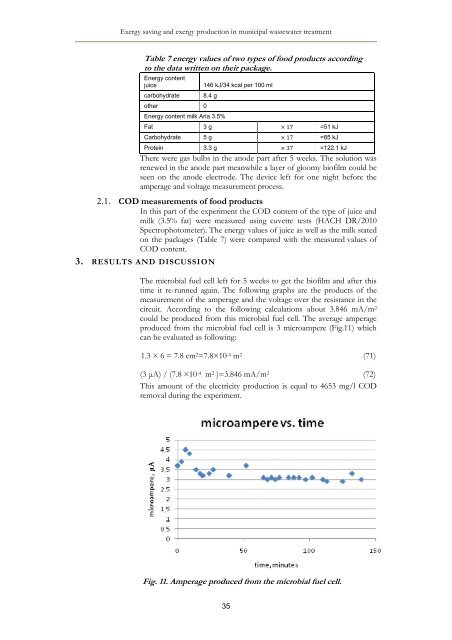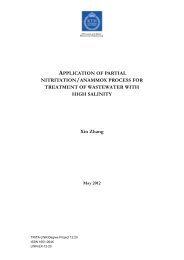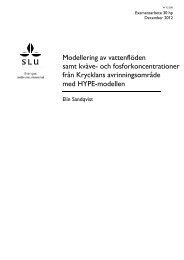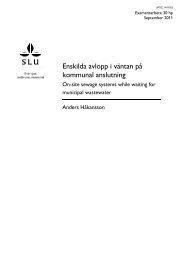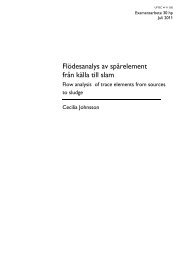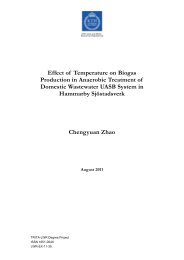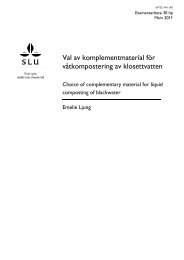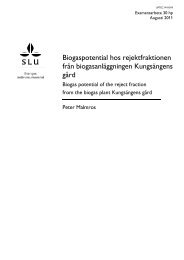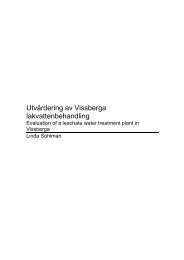Exergy saving and exergy production in municipal wastewater ...
Exergy saving and exergy production in municipal wastewater ...
Exergy saving and exergy production in municipal wastewater ...
You also want an ePaper? Increase the reach of your titles
YUMPU automatically turns print PDFs into web optimized ePapers that Google loves.
<strong>Exergy</strong> <strong>sav<strong>in</strong>g</strong> <strong>and</strong> <strong>exergy</strong> <strong>production</strong> <strong>in</strong> <strong>municipal</strong> <strong>wastewater</strong> treatment<br />
Table 7 energy values of two types of food products accord<strong>in</strong>g<br />
to the data written on their package.<br />
Energy content<br />
juice<br />
carbohydrate<br />
other 0<br />
146 kJ/34 kcal per 100 ml<br />
8.4 g<br />
Energy content milk Arla 3.5%<br />
Fat 3 g =51 kJ<br />
Carbohydrate 5 g =85 kJ<br />
Prote<strong>in</strong> 3.3 g =122.1 kJ<br />
There were gas bulbs <strong>in</strong> the anode part after 5 weeks. The solution was<br />
renewed <strong>in</strong> the anode part meanwhile a layer of gloomy biofilm could be<br />
seen on the anode electrode. The device left for one night before the<br />
amperage <strong>and</strong> voltage measurement process.<br />
2.1. COD measurements of food products<br />
In this part of the experiment the COD content of the type of juice <strong>and</strong><br />
milk (3.5% fat) were measured us<strong>in</strong>g cuvette tests (HACH DR/2010<br />
Spectrophotometer). The energy values of juice as well as the milk stated<br />
on the packages (Table 7) were compared with the measured values of<br />
COD content.<br />
3. RESULTS AND DISCUSSION<br />
The microbial fuel cell left for 5 weeks to get the biofilm <strong>and</strong> after this<br />
time it re-runned aga<strong>in</strong>. The follow<strong>in</strong>g graphs are the products of the<br />
measurement of the amperage <strong>and</strong> the voltage over the resistance <strong>in</strong> the<br />
circuit. Accord<strong>in</strong>g to the follow<strong>in</strong>g calculations about 3.846 mA/m 2<br />
could be produced from this microbial fuel cell. The average amperage<br />
produced from the microbial fuel cell is 3 microampere (Fig.11) which<br />
can be evaluated as follow<strong>in</strong>g:<br />
1.3 × 6 = 7.8 cm 2 =7.8×10 -4 m 2 (71)<br />
(3 μA) / (7.8 ×10 -4 m 2 )=3.846 mA/m 2 (72)<br />
This amount of the electricity <strong>production</strong> is equal to 4653 mg/l COD<br />
removal dur<strong>in</strong>g the experiment.<br />
Fig. 11. Amperage produced from the microbial fuel cell.<br />
35


